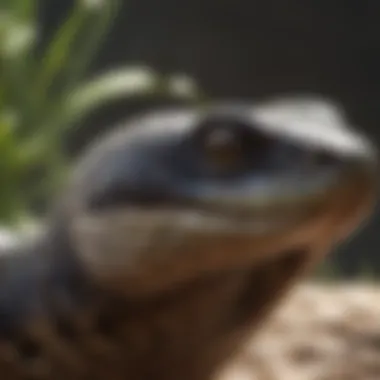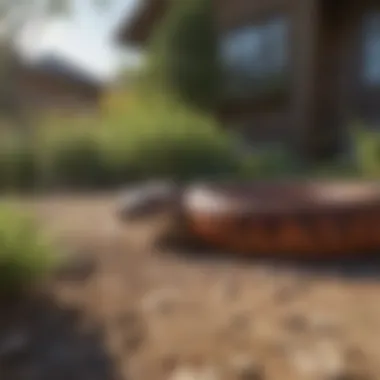Effective Methods for Naturally Deterring Snakes Without Harmful Chemicals


Preventive Pest Control Strategies
To embark on the journey of naturally deterring snakes from your surroundings, it is indispensable to initiate with Preventive Pest Control Strategies. These strategies encompass safeguarding your house exterior, maintaining yard cleanliness, upholding indoor hygiene, disposing of garbage efficiently, and exploring innovative pest prevention techniques. House Exterior Protection entails sealing cracks diligently, clearing debris meticulously, and implementing measures to prevent pests from invading your living space. Yard Maintenance plays a vital role in keeping snakes at bay by performing essential yard care routines and employing methods to maintain a pest-free environment. Indoor Cleanliness is crucial, and expert cleaning tips and techniques must be followed rigorously to ensure a pest-resistant indoor atmosphere. Garbage Disposal seems mundane but is significant, and adopting efficient waste disposal methods is paramount in deterring pests. Lastly, leveraging Other Pest Prevention Strategies showcases your commitment to safeguarding your home effectively.
Understanding Snakes
Understanding snakes is crucial when it comes to deterring them naturally from your surroundings. In this article, we delve into the behavior, types, and habitats of snakes to equip you with the knowledge needed to effectively repel them without the use of harmful substances or traps.
Basic Snake Behavior
Getting a grasp on basic snake behavior is essential in developing strategies to keep them away naturally. Snakes have specific patterns of movement, hunting techniques, and nesting behaviors that play a significant role in understanding how to deter them from your property. By comprehending how snakes act in various situations, you can proactively safeguard your home from potential snake encounters.
Types of Snakes
Identifying different snake species is key to implementing effective deterrence methods. Various snakes have unique characteristics, behaviors, and preferred environments. From venomous to non-venomous species, each type requires specific handling to ensure your safety and their protection. By familiarizing yourself with the types of snakes in your area, you can tailor your prevention techniques accordingly, promoting a harmonious coexistence with these reptiles.
Common Habitats for Snakes
Recognizing the common habitats where snakes thrive is fundamental in snake deterrence. Snakes are often found in tall grass, woodpiles, rock crevices, and near water sources. Understanding their habitat preferences enables you to take proactive steps such as clearing clutter, minimizing shrubbery, and sealing potential entry points to discourage snakes from settling in your vicinity. By addressing these favored habitats, you create an environment less conducive for snakes to inhabit, reducing the likelihood of unwelcome visits.
Natural Snake Repellents


Natural Snake Repellents play a vital role in this article on deterring snakes naturally. These repellents offer a safer alternative to harmful chemicals or traps, ensuring a non-toxic approach to keeping snakes away. By harnessing the power of essential oils, plants, herbs, and natural predators, individuals can safeguard their living spaces effectively. The significance of these repellents lies in their efficacy without posing harm to the environment or the snakes themselves. When exploring natural snake repellents, it is essential to consider factors such as sustainability, affordability, and accessibility to make informed choices.
Essential Oils
Peppermint Oil
Peppermint Oil stands out as a key player in deterring snakes naturally. Its strong scent acts as a powerful repellent, disrupting snakes' sensory perception and deterring them from entering specific areas. The refreshing aroma of Peppermint Oil not only serves as a natural barrier against snakes but also adds a pleasant fragrance to the surroundings. Its non-toxic nature makes it a preferred choice for environmentally conscious individuals seeking effective snake repellents. However, regular reapplication may be necessary to maintain its potency for ongoing protection.
Clove Oil
Clove Oil offers a unique contribution to natural snake repellents with its potent aroma and pesticidal properties. Its strong scent overwhelms snakes' olfactory senses, making it difficult for them to navigate through treated areas. Additionally, Clove Oil possesses natural insecticidal properties, further enhancing its repellent capabilities. While highly effective, Clove Oil should be used judiciously due to its concentrated nature, requiring dilution for safe application around living spaces.
Cinnamon Oil
Cinnamon Oil emerges as a versatile option for deterring snakes naturally, thanks to its strong scent and antifungal properties. The rich aroma of Cinnamon Oil disrupts snakes' navigation patterns, creating an inhospitable environment for them. Moreover, its antifungal properties offer added benefits by promoting a healthier ecosystem in treated areas. Utilizing Cinnamon Oil as a snake repellent combines pest-control efficacy with environmental sustainability.
Plants and Herbs
Marigolds
Marigolds serve as natural snake repellents, emitting a scent that snakes find unpleasant. These vibrant flowers not only enhance the aesthetic appeal of gardens but also act as a barrier against snakes. Their natural compounds deter snakes effectively while attracting beneficial insects, contributing to overall garden health. Incorporating Marigolds into landscaping not only adds visual charm but also offers practical protection against unwanted reptilian visitors.
Lemongrass


Lemongrass plays a dual role in deterring snakes naturally by repelling them and attracting their natural predators. The citrusy aroma of Lemongrass creates an unfavorable environment for snakes, serving as a natural barrier. Simultaneously, Lemongrass attracts predators such as birds and cats, creating a natural balance in the ecosystem. This strategic use of Lemongrass promotes a harmonious coexistence between humans, snakes, and their predators.
Onions and Garlic
Onions and Garlic act as natural snake repellents due to their strong odors that snakes avoid. These common kitchen ingredients serve a protective function in gardens and homes, warding off snakes with their pungent aromas. Both Onions and Garlic can be strategically planted or placed around entry points to deter snakes effectively. Their dual purpose as culinary staples and natural repellents makes them accessible and sustainable choices for keeping snakes at bay.
Natural Predators
Natural predators play a crucial role in deterring snakes naturally by maintaining ecological balance and regulating snake populations. Harnessing the presence of predators such as birds of prey, cats, and certain snake species helps control snake numbers while deterring them from human-inhabited spaces naturally. By fostering a habitat that supports natural predator-prey relationships, individuals can mitigate snake encounters without resorting to harmful chemicals or traps. Supporting the presence of natural predators contributes to a holistic approach to snake deterrence, ensuring a balanced ecosystem.
Home Modifications
In the realm of snake deterrence, home modifications play a pivotal role in ensuring a snake-free environment. By fortifying your residence against potential intruders, you not only protect your household but also promote peace of mind. One crucial aspect of home modifications involves sealing all possible entry points where snakes could slither through. This could include crevices in walls, gaps in doors, or openings around utility conduits. Such meticulous attention to detail can effectively prevent snakes from trespassing into your abode. Moreover, emphasizing home modifications underscores a proactive approach to snake control, encouraging homeowners to take charge of their surroundings.
Sealing Entry Points
Sealing entry points is a fundamental aspect of home modifications to deter snakes naturally. By carefully inspecting and sealing off any openings that could serve as entry points for snakes, homeowners significantly minimize the risk of snake encounters indoors. Common entry points that require attention include gaps beneath doors, holes in window screens, cracks in the foundation, and spaces around pipes or cables. Utilizing materials such as caulk, weatherstripping, door sweeps, and mesh screens can aid in effectively blocking these access points. By addressing these vulnerabilities, individuals can create a more secure home environment that is less attractive to unwelcome serpentine visitors.
Decluttering
Decluttering plays a vital role in snake prevention within residential settings. Piles of debris, stacks of wood, overgrown vegetation, and untidy storage areas can inadvertently create inviting spaces for snakes to hide, nest, or seek shelter. By decluttering both indoor and outdoor spaces, homeowners eliminate potential snake habitats and reduce the likelihood of snake encounters. Clearing out clutter not only disrupts snakes' preferred environments but also enhances visibility, making it easier to spot and deter any unwelcome reptilian guests. Additionally, maintaining a clutter-free home promotes better organization and overall cleanliness, contributing to a more harmonious living environment.
Proper Yard Maintenance


Proper yard maintenance is crucial in the natural deterrence of snakes around residential properties. By regularly mowing lawns, trimming vegetation, and removing tall grass and weeds, homeowners can eliminate hiding spots and breeding grounds for snakes. Keeping the surroundings well-manicured and free of dense foliage reduces the appeal of the area to snakes, encouraging them to seek shelter elsewhere. Furthermore, maintaining a tidy yard facilitates easy monitoring of snake activity, allowing homeowners to detect any potential issues promptly. Implementing a consistent yard maintenance routine not only enhances the aesthetic appeal of the property but also serves as a proactive measure against unwanted snake presence.
Behavioral Changes
In the realm of natural snake deterrence, behavioral changes play a pivotal role in maintaining a snake-free environment around your abode. These changes are essential in disrupting the factors that attract snakes in the first place, prompting them to seek shelter or food on your premises. By implementing strategic behavioral alterations, you can effectively deter snakes without relying on harmful chemicals or inhumane traps. The significance of focusing on behavioral changes lies in the long-term effectiveness it brings to snake control, ensuring that your space remains a deterrent to these reptilian visitors.
Limiting Food Sources
Limiting food sources is a crucial aspect of snake deterrence as it directly influences the presence of snakes in your vicinity. Snakes are attracted to areas abundant in prey such as rodents, insects, and even small animals. By practicing proper waste management, securing trash bins, and eliminating potential food sources, you diminish the allure of your space to snakes. This proactive measure not only reduces the likelihood of snakes lingering in search of food but also contributes to a cleaner and healthier environment for you and your household.
Reducing Shelter Options
Reducing shelter options is instrumental in discouraging snakes from taking up residence in your surroundings. Snakes seek out dark, secluded spaces for shelter and breeding, making cluttered and unkempt areas ideal habitats. By decluttering your yard, removing piles of stacked materials, and sealing off potential hiding spots, you create an inhospitable environment for snakes. This proactive approach minimizes the chances of snakes finding shelter on your property, forcing them to seek alternative locations away from your living space.
Creating Vibrations
Creating vibrations is a novel yet effective method of snake deterrence that capitalizes on disrupting a snake's sensory perception. Snakes rely heavily on their ability to sense vibrations in the ground to navigate their surroundings and detect potential threats or prey. By utilizing vibrating devices or implementing regular lawn maintenance activities that produce vibrations, you can deter snakes from settling in your yard. This tactile approach creates an environment that feels hostile and unsettling to snakes, encouraging them to seek refuge elsewhere. Implementing this technique alongside other natural repellents enhances your overall snake deterrence strategy, offering a comprehensive solution for keeping snakes at bay.
Professional Assistance
When dealing with a snake issue, professional assistance can be crucial to ensuring an effective and safe resolution. Professional wildlife services are equipped with the knowledge, experience, and tools necessary to handle snakes appropriately. One significant benefit of seeking professional help is the expertise they bring to correctly identify snake species, assess potential risks, and develop tailored solutions. Moreover, professionals are well-versed in local regulations around wildlife handling, ensuring compliance and ethical treatment of snakes. When facing complex or large-scale infestations, relying on experts can save time and avoid potential dangers.
When to Call Experts
Knowing when to call snake removal experts is essential for addressing snake problems promptly and effectively. If you encounter venomous snakes or large snake populations on your property, it is safest to contact professionals immediately. Other signs that warrant expert intervention include recurrent snake sightings, nesting behaviors, or unexplained snake activities. Although attempting DIY removal might seem tempting, it can pose significant risks and challenges without proper training or gear. By recognizing the limits of personal abilities and seeking professional help promptly, homeowners can ensure a swift and secure resolution to snake issues.
Choosing Reputable Wildlife Services
Selecting the right wildlife service for snake management is crucial for a successful and humane outcome. When choosing a wildlife removal company, consider factors such as their license, insurance coverage, and experience in handling snakes. Reputable services should prioritize animal welfare, employing humane removal techniques and eco-friendly practices. Additionally, investigate customer reviews and testimonials to gauge the company's reputation and reliability. Prioritize companies that offer a comprehensive approach to snake management, including prevention strategies alongside removal services. By investing time in selecting a trusted and ethical wildlife service, homeowners can rest assured that their snake issues will be addressed responsibly and effectively.



